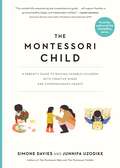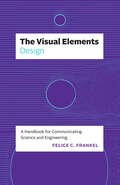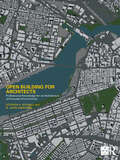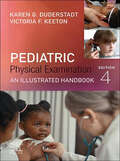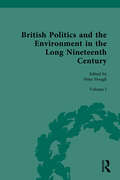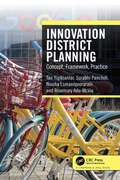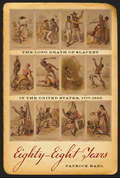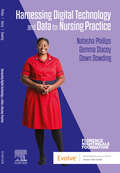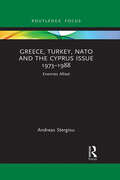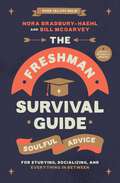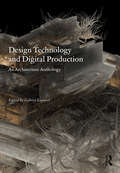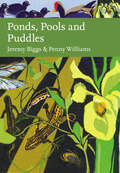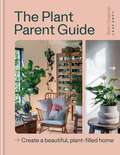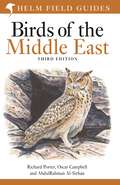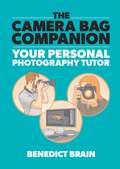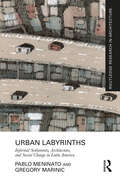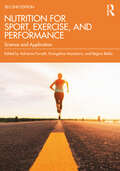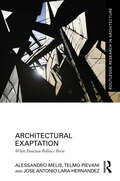- Table View
- List View
The Montessori Child: A Parent's Guide to Raising Capable Children with Creative Minds and Compassionate Hearts (The Parents' Guide to Montessori #3)
by Simone Davies Junnifa UzodikeFrom the bestselling authors of The Montessori Toddler and The Montessori Baby, this book guides parents through the principles of Montessori to enhance their children's development and foster respectful relationships with their families and the world. When children are given independence, the tools to succeed, and the encouragement to build on their abilities, it&’s amazing what they can achieve. The newest book in the bestselling Montessori series is an everything-you-need-to-know guide to raising your school-aged child (from 3–12 years old, with a bonus chapter for the teen years) in the Montessori way. Educators Simone Davies and Junnifa Uzodike provide an in-depth, practical guide to incorporating Montessori principles into readers&’ everyday lives, with advice on everything from setting up your home in ways that encourage curiosity and independence to supporting your child&’s social and moral development with a balance of limit-setting and age-appropriate freedoms. The book includes dozens of hands-on activities to help foster your child's love of numbers and literacy, art and science, and ones that encourage community-building, social awareness, and connection with the natural world. The Montessori Child offers a powerful alternative for parents who feel that family life has gotten too complicated by showing parents how to make more intentional choices for your family, how to better understand the needs of your children, and support them as they develop their unique potential.
The Visual Elements—Design: A Handbook for Communicating Science and Engineering (The Visual Elements)
by Felice C. FrankelWith insights and examples from designers at publications from Nature to the New York Times, an essential guide to creating figures and presentations. In this short handbook, award-winning science communicator Felice C. Frankel offers a quick guide for scientists and engineers who want to share—and better understand—their research by designing compelling graphics for journal submissions, grant applications, presentations, and posters. Like all the books in the Visual Elements series, this handbook is also a training tool for researchers. Distilling her celebrated books and courses to the essentials, Frankel shows scientists and engineers, from students to primary investigators, the importance of thinking visually. This crucial volume in the Visual Elements series offers a wealth of engaging design examples. Case studies and advice from designers at prestigious publications and researchers’ own before-and-after examples show how even the smallest changes—to color, type, composition, and layering—can greatly improve communication. Ideal for researchers who want a foothold for presenting and preparing their work for everything from conferences to publications, the book explains the steps for creating a concise and communicative graphic to highlight the most important aspects of research—and to clarify researchers’ own thinking. The resulting book is an essential element of any scientist’s, engineer’s, or designer’s library.
The Visual Elements—Design: A Handbook for Communicating Science and Engineering (The Visual Elements)
by Felice C. FrankelWith insights and examples from designers at publications from Nature to the New York Times, an essential guide to creating figures and presentations. In this short handbook, award-winning science communicator Felice C. Frankel offers a quick guide for scientists and engineers who want to share—and better understand—their research by designing compelling graphics for journal submissions, grant applications, presentations, and posters. Like all the books in the Visual Elements series, this handbook is also a training tool for researchers. Distilling her celebrated books and courses to the essentials, Frankel shows scientists and engineers, from students to primary investigators, the importance of thinking visually. This crucial volume in the Visual Elements series offers a wealth of engaging design examples. Case studies and advice from designers at prestigious publications and researchers’ own before-and-after examples show how even the smallest changes—to color, type, composition, and layering—can greatly improve communication. Ideal for researchers who want a foothold for presenting and preparing their work for everything from conferences to publications, the book explains the steps for creating a concise and communicative graphic to highlight the most important aspects of research—and to clarify researchers’ own thinking. The resulting book is an essential element of any scientist’s, engineer’s, or designer’s library.
Open Building for Architects: Professional Knowledge for an Architecture of Everyday Environment (Open Building)
by Stephen H. Kendall N. John HabrakenOpen Building is an internationally recognized approach to the design of buildings and building complexes with roots in the way the ordinary built environment grows and regenerates. The Open Building approach recognizes that both stability and change are realities to be managed in the contemporary built environment. Buildings – and the neighborhoods they occupy – are not static during the most stable times or during times of rapid social and technical change. They are living organisms that need constant adjustments to remain attractive, safe and valuable.Using case studies of built projects from around the world, this book explains the Open Building approach and discusses important characteristics of everyday built environment that the Open Building approach designs for. It also presents a key method that can be used to put the approach into use. It addresses questions such as: How can we design large projects for inevitable change? How can we balance the demands of large projects for efficient implementation with the need for ‘fine-grained’ decision-making control? How can we separate design tasks, one task being the design of what should last a century, the other task being the design of more mutable units of occupancy? How can we identify and share architectural themes and, at the same time, make variations on them? How can we use the Open Building approach to steward the earth’s scarce resources and contribute to a circular economy that benefits all people? This book is an essential resource for practitioners, investors and developers, regulators, builders, product manufacturers and educators interested in why the Open Building approach matters and how to practice Open Building.
Pediatric Physical Examination - E-Book: Pediatric Physical Examination - E-Book
by Karen G. Duderstadt Victoria F. KeetonKnown for its accuracy, consistency, and portability, Pediatric Physical Examination: An Illustrated Handbook, 4th Edition teaches the unique range of skills that Nurse Practitioners and primary care providers need to assess children of all ages. Spiral-bound for quick reference in clinical settings, this photo-rich, step-by-step guide to physical examination prepares you to expertly examine children from birth through adolescence. Body system chapters begin with fetal development and take you through the key developmental stages of childhood. This edition features new sections with Telehealth Tips and Considerations for Special Populations in many chapters, as well as expanded coverage of maltreatment, mental health, and social disparities of health.Expert guidance for the pediatric physical exam employs the "quiet-to-active" approach, starting with the listening parts of the physical exam and moving on to the hands-on components, the physical assessment approach that yields the best results in the pediatric age group. Quick-reference features include special tables/boxes, such as Information Gathering, Conditions, Pediatric Pearls, Red Flags, Interprofessional Collaboration Notes, Evidence-Based Practice, and EHR Documentation.Easy-to-use layout provides quick access to concise guidance for the pediatric physical exam.Richly illustrated, full-color format facilitates readability and learning with more than 300 photos and line drawings of assessment techniques and common assessment findings.Inclusive and ethnically diverse illustrations better represent the diverse populations pediatric health care providers work with every day.NEW! Telehealth Tips section added to chapters reflects the greatly expanded use of telehealth visits in clinical practice.NEW! Information on maltreatment, mental and behavioral health, and social determinants of health explored throughout the chapters.NEW! Considerations for special needs populations added to most chapters.NEW! Guidance on use of screen time for early childhood and advice for families.
British Politics and the Environment in the Long Nineteenth Century: Volume I - Discovering Nature and Romanticizing Nature
by Peter HoughThis volume of archival source material chronicles British environmental politics between 1789 and 1914. This text examines scientific discoveries during this period and the result of these findings on the political environment, bringing the public's attention to public health issues such as acid rain and river pollution. Accompanied by extensive editorial commentary, this collection will be of great interest to students of environmental and political history.
Innovation District Planning: Concept, Framework, Practice
by Tan Yigitcanlar Surabhi Pancholi Niusha Esmaeilpoorarabi Rosemary Adu-McVieThis book aims to fill the knowledge gap on how to plan, develop and manage innovation districts that are competitive in terms of both productivity and quality of living, justifying the massive investment put into place and at the same time doing both in a delicate and harmonious way.There is a need for smart urban land use that is wired with both hard infrastructures (e.g., telecommunication and transport) and soft infrastructures (e.g., diversity and tolerance). The reader learns this knowledge through conceptual expansions for key insights, frameworks for potential and performance assessment and best practices for global innovation districts. The authors begin innovation district planning with the role and effectiveness of planning a branding in the development of innovation districts. The next key topic of place making is recognised as a key strategy for supporting knowledge generation and innovation activities in the contemporary innovation districts. Another important topic is place quality where the reader learns to identify and classify indicators of place quality by studying global innovation districts best practices. The reader also expands their understanding on the classification of innovation districts based on their key characteristics through a methodological approach. The book concludes with district smartness studied through the socio-cultural role played by anchor universities in facilitating place making in innovation districts. Smart campuses, enabled by digital transformation opportunities in higher education, are seen as a miniature replica of smart cities and serve as living labs for smart technology.The book serves as a repository for scholars, researchers, postgraduate and undergraduate students as it communicates the complex innovation district phenomenon in an easy-to-digest form by providing both the big picture view and specifics of each component of that view.
Children's Writers' & Artists' Yearbook 2020: Improvisation And The Theatre (Writers' and Artists')
by Bloomsbury PublishingForeword by William Sutcliffe, author of Are you Experienced?, New Boy and We See EverythingThe indispensable guide to writing for children and young adults, this Yearbook provides inspirational articles from successful writers and illustrators, as well as practical advice on who to contact across the media and how to get published.New articles for the 2020 edition include:- Davinia Andrew-Lynch A message for under-represented writers: We Want You- Clémentine Beauvais Writing and translating children's fiction- Holly Bourne Dealing with tough issues in YA fiction- Natasha Farrant Writing about love and loss for children- Kiran Millwood Hargrave Writing magic into fiction- Salvatore Rubbino The craft of the illustrator- Deirdre Sullivan Reinventing old stories for new readers
Life is Limited..Live Unlimited: Improvisation And The Theatre (Bloomsbury Revelations Ser.)
by Mr Sanjiva DubeyLife is Limited.. Live Unlimited recounts a fascinating personal transformational journey. This book is a rich blend of modern thinking and technology usage, drawing heavily from age old Indian scriptures to arrive at the transformational prescriptions which are simple to understand and easy to adopt. This book is for all new age individuals, professionals, students, home makers, business persons who wish to strike the right work life balance and be happy and satisfied without sacrificing their career goals. Using the tips, tools and techniques from this book they can achieve the unlimited potential of life in a limited time span, apart from enjoying the anecdotes, shlokas and teachings from gurus.
Harnessing Digital Technology and Data for Nursing Practice - E-Book
by Natasha Phillips Gemma Stacey Dawn DowdingAs new technologies and data become essential for the delivery of optimal care, nurses will play an increasingly vital role in developing and implementing digital health strategies. This timely book is designed to help you develop proficiency and confidence to lead this digital transformation.Harnessing Digital Technology and Data for Nursing Practice provides comprehensive coverage of the historical, theoretical and practical dimensions of the digital transformation in nursing. It considers a wide range of topics, from person-centred practice and user-centred design to nursing workforce development, evolving nursing practices, and the role of data in improving patient care and research. Expert insights are supported by learning activities and real-life case studies, with application of theory to practice throughout.Aimed at nurses in all settings and working at all professional levels, this book will leave the reader with an appreciation of how an array of digital technologies and data can positively impact nurses’ wellbeing, support and improve your daily practice, and ultimately ensure patient-centred, safe and effective care.Written specifically for nurses and midwives – explains how you can play a central role in shaping the digital future of health careProvides historical, theoretical and practical perspectives – offers a sound base from which to understand the role of data technology in your workCovers a wide spectrum of topics, including: digital transformation of health carenursing informaticsuser-centred designdata-driven practiceperson-centred carehealth inequalitiestelehealth and remote monitoringethical and legal considerationspopulation healthresearchProvides practical insights and case studies to help you apply digital technologies in practiceAcknowledges the challenges in adopting digital health, and stresses the importance of digital literacy and nurse involvement in the design and implementation of digital solutionsGlobally relevant and future oriented – creates a vision for nurses as co-navigators of care who make decisions informed by real-time patient analyticsAncillary videos to support learning
Greece, Turkey, NATO and the Cyprus Issue 1973–1988: Enemies Allied (Europa Regional Perspectives)
by Andreas StergiouThe volume examines one of the most sensitive issues in the contemporary diplomatic history of the eastern Mediterranean, namely, the nexus between Greece, Turkey, the Cyprus problem and NATO in the crucial period between 1973 and 1988. Beginning with the emergence of the Aegean dispute in 1973 and ending with the most comprehensive attempt to date to solve the Greek–Turkish conflict in the wake of the Davos rapprochement process in 1988. The analysis in this book goes back to developments that occurred in the first half of the 20th century.
Greece, Turkey, NATO and the Cyprus Issue 1973–1988: Enemies Allied (Europa Regional Perspectives)
by Andreas StergiouThe volume examines one of the most sensitive issues in the contemporary diplomatic history of the eastern Mediterranean, namely, the nexus between Greece, Turkey, the Cyprus problem and NATO in the crucial period between 1973 and 1988. Beginning with the emergence of the Aegean dispute in 1973 and ending with the most comprehensive attempt to date to solve the Greek–Turkish conflict in the wake of the Davos rapprochement process in 1988. The analysis in this book goes back to developments that occurred in the first half of the 20th century.
The Freshman Survival Guide: Soulful Advice for Studying, Socializing, and Everything In Between
by Nora Bradbury-Haehl Bill McGarveyA completely revised and updated values-based guide to navigating the first year of college that speaks to college students in their own language and offers practical tools that readers need to keep from drinking, sleeping, or skipping their way out of college. In the four years since its initial publication, The Freshman Survival Guide has helped thousands of first year students make a successful transition to college life. However, much has changed on campuses. The explosion of technology, ubiquity of social media, and culture changes have all added new layers of complexity to the leap from high school to college. The Freshman Survival Guide's updated edition features new research and advice on issues such as mental health, sexual assault, and finding balance. It also features expanded sections on dating, money management, and an increased focus on how the over 1.5 million incoming freshman can prepare themselves for the biggest change they've encountered in their lives: heading off to college.
Design Technology and Digital Production: An Architecture Anthology
by Gabriel EsquivelThis book is a rigorous account of architecture’s theoretical and technological concerns over the last decade. The anthology presents projects and essays produced at the end of the first digital turn and the start of the second digital turn. This anthology engages and deploys a variety of discourses, topics, criteria, pedagogies, and technologies, including some of today’s most influential architects, practitioners, academics, and critics. It is an unflinchingly rigorous and unapologetic account of architecture’s disciplinary concerns in the last decade. This is a story that has not been told; in recent years everything has been refracted through the prism of the post-digital generation.Design Technology and Digital Production illustrates the shift to an architectural world where we can learn with and from each other, develop a community of new technologies and embrace a design ecology that is inclusive, open, and visionary. This collection fosters a sense of shared experience and common purpose, along with a collective responsibility for the well-being of the discipline of architecture as a whole.
Design Technology and Digital Production: An Architecture Anthology
This book is a rigorous account of architecture’s theoretical and technological concerns over the last decade. The anthology presents projects and essays produced at the end of the first digital turn and the start of the second digital turn. This anthology engages and deploys a variety of discourses, topics, criteria, pedagogies, and technologies, including some of today’s most influential architects, practitioners, academics, and critics. It is an unflinchingly rigorous and unapologetic account of architecture’s disciplinary concerns in the last decade. This is a story that has not been told; in recent years everything has been refracted through the prism of the post-digital generation.Design Technology and Digital Production illustrates the shift to an architectural world where we can learn with and from each other, develop a community of new technologies and embrace a design ecology that is inclusive, open, and visionary. This collection fosters a sense of shared experience and common purpose, along with a collective responsibility for the well-being of the discipline of architecture as a whole.
Ponds, Pools and Puddles (Collins New Naturalist Library)
by Jeremy Biggs Penny WilliamsPonds and pools are a common feature of our landscape – there are at least ten times as many ponds as lakes in the UK – and they are also important wildlife habitats. This book provides a comprehensive and detailed account of these freshwater habitats.
The Plant Parent Guide: Create a beautiful, plant-filled home
by Beth ChapmanDid you know we spend an average of 90% of our time indoors? With the air-purifying, mind-calming, stress-relieving and productivity-boosting power of houseplants well established, it is time to transform your home with plants.Created by leading houseplant brand Leaf Envy, The Plant Parent Guide is here to reveal the incredible world of houseplants, but also teach you to select, style and care for them in the best way to suit your space.Upgrade your home with perfectly placed greenery by following the bespoke styling guides for every room, from shaded bedrooms to steamy bathrooms. Whether you're looking for the perfect Zoom backdrop or an oasis of calm in a busy kitchen, there are plenty of tips and tricks for choosing the best plants to suit your light, upkeep and styling requirements.Easy-to-follow care guides make becoming a plant parent pro simple, with advice for every season to ensure your plants flourish year-round. For houseplant newbies there are recommendations for the species hardest to kill, while for the already green-fingered there are ideas for more unusual plants to introduce, and instructions for mastering the art of propagation. With The Plant Parent Guide, any home can become a beautiful and thriving plant-filled space.Photography by Taran Wilkhu.
Field Guide to Birds of the Middle East: Third Edition (Helm Field Guides)
by Richard Porter Oscar Campbell Mr AbdulRahman Al-SirhanThe ultimate field guide to the birds of the Middle East, an indispensable companion for any traveller to the region The Middle East – the region stretching from Cyprus and the Levant to Iran, including Turkey and the Arabian Peninsula, plus Socotra – has a wonderfully broad and diverse avifauna, featuring a host of wintering and passage migrants, enigmatic breeders, and even a few endemics that occur nowhere else. This authoritative book covers more than 895 species recorded in the Middle East, including details of all regular visitors and breeding species, from the Purple Sunbird to the Northern Bald Ibis. Featuring 180 stunning colour plates by three of the world's leading bird illustrators, this practical guide also includes concise species accounts describing key identification features, status, range, habitat and voice with fully updated distribution maps for each species. Written by three of the leading lights in regional ornithology and conservation, this fully revised and expanded guide is an essential reference for any birder living in or visiting the Middle East.
Field Guide to Birds of the Middle East: Third Edition (Helm Field Guides)
by Richard Porter Oscar Campbell Mr AbdulRahman Al-SirhanThe ultimate field guide to the birds of the Middle East, an indispensable companion for any traveller to the region The Middle East – the region stretching from Cyprus and the Levant to Iran, including Turkey and the Arabian Peninsula, plus Socotra – has a wonderfully broad and diverse avifauna, featuring a host of wintering and passage migrants, enigmatic breeders, and even a few endemics that occur nowhere else. This authoritative book covers more than 895 species recorded in the Middle East, including details of all regular visitors and breeding species, from the Purple Sunbird to the Northern Bald Ibis. Featuring 180 stunning colour plates by three of the world's leading bird illustrators, this practical guide also includes concise species accounts describing key identification features, status, range, habitat and voice with fully updated distribution maps for each species. Written by three of the leading lights in regional ornithology and conservation, this fully revised and expanded guide is an essential reference for any birder living in or visiting the Middle East.
The Camera Bag Companion: A Graphic Guide to Photography
by Benedict BrainAre you ready for a completely new type of photography book?Imagine having your personal, professional photographer with you whenever you go out to shoot. There to guide you, share their knowledge, and inspire you to take better photographs.In his latest book, Benedict Brain puts himself in your kitbag, with a beautifully illustrated how-to guide that's as essential as any lens or tripod, and cuts through the jargon to deliver clear advice in a friendly, conversational style.
Urban Labyrinths: Informal Settlements, Architecture, and Social Change in Latin America (Routledge Research in Architecture)
by Pablo Meninato Gregory MarinicUrban Labyrinths: Informal Settlements, Architecture, and Social Change in Latin America examines intervention initiatives in informal settlements in Latin American cities as social, spatial, architectural, and cultural processes. From the mid-20th century to the present, Latin America and other regions in the Global South have experienced a remarkable demographic trend, with millions of people moving from rural areas to cities in search of work, healthcare, and education. Without other options, these migrants have created self-built settlements mostly located on the periphery of large metropolitan areas. While the initial reaction of governments was to eliminate these communities, since the 1990s, several Latin American cities began to advance new urban intervention approaches for improving quality of life. This book examines informal settlement interventions in five Latin American cities: Rio de Janeiro, Medellín, São Paulo, Buenos Aires, and Tijuana. It explores the Favela-Bairro Program in Rio de Janeiro during the 1990s which sought to improve living conditions and infrastructure in favelas. It investigates projects propelled by Social Urbanism in Medellín at the beginning of the 2000s, aimed at revitalizing marginalized areas by creating a public transportation network, constructing civic buildings, and creating public spaces. Furthermore, the book examines the long-term initiatives led by SEHAB in São Paulo, which simultaneously addresses favela upgrading works, water pollution remediation strategies, and environmental stewardship. It discusses current intervention initiatives being developed in informal settlements in Buenos Aires and Tijuana, exploring the urban design strategies that address complex challenges faced by these communities. Taken together, the Latin American architects, planners, landscape architects, researchers, and stakeholders involved in these projects confirm that urbanism, architecture, and landscape design can produce positive urban and social transformations for the most underprivileged.This book will be of interest to students, researchers, and professionals in planning, urbanism, architecture, urban design, landscape architecture, urban geography, public policy, as well as other spatial design disciplines.
Urban Labyrinths: Informal Settlements, Architecture, and Social Change in Latin America (Routledge Research in Architecture)
by Pablo Meninato Gregory MarinicUrban Labyrinths: Informal Settlements, Architecture, and Social Change in Latin America examines intervention initiatives in informal settlements in Latin American cities as social, spatial, architectural, and cultural processes. From the mid-20th century to the present, Latin America and other regions in the Global South have experienced a remarkable demographic trend, with millions of people moving from rural areas to cities in search of work, healthcare, and education. Without other options, these migrants have created self-built settlements mostly located on the periphery of large metropolitan areas. While the initial reaction of governments was to eliminate these communities, since the 1990s, several Latin American cities began to advance new urban intervention approaches for improving quality of life. This book examines informal settlement interventions in five Latin American cities: Rio de Janeiro, Medellín, São Paulo, Buenos Aires, and Tijuana. It explores the Favela-Bairro Program in Rio de Janeiro during the 1990s which sought to improve living conditions and infrastructure in favelas. It investigates projects propelled by Social Urbanism in Medellín at the beginning of the 2000s, aimed at revitalizing marginalized areas by creating a public transportation network, constructing civic buildings, and creating public spaces. Furthermore, the book examines the long-term initiatives led by SEHAB in São Paulo, which simultaneously addresses favela upgrading works, water pollution remediation strategies, and environmental stewardship. It discusses current intervention initiatives being developed in informal settlements in Buenos Aires and Tijuana, exploring the urban design strategies that address complex challenges faced by these communities. Taken together, the Latin American architects, planners, landscape architects, researchers, and stakeholders involved in these projects confirm that urbanism, architecture, and landscape design can produce positive urban and social transformations for the most underprivileged.This book will be of interest to students, researchers, and professionals in planning, urbanism, architecture, urban design, landscape architecture, urban geography, public policy, as well as other spatial design disciplines.
Nutrition for Sport, Exercise, and Performance: Science and Application
by Adrienne Forsyth Evangeline Mantzioris Regina BelskiNutrition for Sport, Exercise, and Performance offers a clear, practical, and accessible guide to building a comprehensive understanding of sport and exercise nutrition from leading experts in nutrition and exercise science. Nutrition before, during, and after training or a sporting event can improve the comfort, energy, and performance of athletes of all levels, from elite to recreational, as well as providing long-term health benefits. As such, nutrition is a key element of an athlete’s health and performance strategy, whether competing recreationally or at an elite level.Split into three parts, this new and revised edition of Nutrition for Sport, Exercise, and Performance provides an evidence-based introduction to nutrition for sport, exercise, and performance. Part I focusses on nutrition and sport science by explaining key principles underpinning sports nutrition science, including energy systems, exercise physiology and metabolism, and the digestion and absorption of macronutrients and micronutrients essential for performance and discusses factors influencing dietary intake, energy availability, and the process of dietary assessment. Part II is focussed on nutrition for exercise, pre- and post-training, hydration, supplements, and body composition measurement and modification. The final part (Part III) focusses on applied sports nutrition for a range of sports and athletes. This second edition delivers new insights into working with female athletes, occupational athletes, and athletes in contemporary sports including sport climbing, surfing, skateboarding, and breaking.Featuring contributions from a range of sport and exercise nutrition professionals with practical sports nutrition strategies and the latest evidence and practice guidelines, this is a core reference for undergraduate students, sports professionals, and aspiring athletes alike.
Nutrition for Sport, Exercise, and Performance: Science and Application
Nutrition for Sport, Exercise, and Performance offers a clear, practical, and accessible guide to building a comprehensive understanding of sport and exercise nutrition from leading experts in nutrition and exercise science. Nutrition before, during, and after training or a sporting event can improve the comfort, energy, and performance of athletes of all levels, from elite to recreational, as well as providing long-term health benefits. As such, nutrition is a key element of an athlete’s health and performance strategy, whether competing recreationally or at an elite level.Split into three parts, this new and revised edition of Nutrition for Sport, Exercise, and Performance provides an evidence-based introduction to nutrition for sport, exercise, and performance. Part I focusses on nutrition and sport science by explaining key principles underpinning sports nutrition science, including energy systems, exercise physiology and metabolism, and the digestion and absorption of macronutrients and micronutrients essential for performance and discusses factors influencing dietary intake, energy availability, and the process of dietary assessment. Part II is focussed on nutrition for exercise, pre- and post-training, hydration, supplements, and body composition measurement and modification. The final part (Part III) focusses on applied sports nutrition for a range of sports and athletes. This second edition delivers new insights into working with female athletes, occupational athletes, and athletes in contemporary sports including sport climbing, surfing, skateboarding, and breaking.Featuring contributions from a range of sport and exercise nutrition professionals with practical sports nutrition strategies and the latest evidence and practice guidelines, this is a core reference for undergraduate students, sports professionals, and aspiring athletes alike.
Architectural Exaptation: When Function Follows Form (Routledge Research in Architecture)
by Alessandro Melis Telmo Pievani Jose Antonio Lara-HernandezArchitectural Exaptation: When Function Follows Form focuses on the significance and the originality of the study of exaptation. It presents exaptation as an opportunity to extend architectural design towards more sustainable approaches aimed at enforcing urban resilience.The use of exaptation’s definition in architecture supports the heuristic value of cross-disciplinary studies on biology and architecture, which seem even more relevant in times of global environmental crises. This book aims to make a critique of the pre-existing and extensive paternalistic literature. Exaptation will be described as a functional shift of a structure that already had a prior, but different, function. In architecture, a functional shift of a structure that already had a function may apply to forms of decorative elements embedded in architectural components, and to both change of function of tectonic elements and the change of use of an architectural space. The book is illustrated with examples from around the globe, including China, Italy, Mexico, New Zealand, the USA and the UK, and looks at different civilizations and diverse historical periods, ranging from the urban to the architectural scale. Such examples highlight the potential and latent human creative capacity to change the use and functions, something that cities and buildings could consider when facing disturbances. Exaptation is shown as an alternative narrative to the simplifications of evolutionary puritanism. It also offers an innovative perspective and presents an opportunity to re-think the manner in which we design and redesign our cities.This book will be of interest to architecture, planning, urban design and biology researchers and students.
